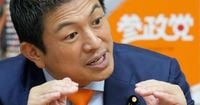Outside a bustling train station near Tokyo, a crowd gathers, their cheers echoing as Sohei Kamiya, the head of the nationalist Sanseito party, takes the stage. With a voice that cuts through the noise, Kamiya rails against Japan’s rapidly growing foreign population. His words strike a chord with many in the audience, who, like retiree Kenzo Hagiya, feel that “Mr. Kamiya is spelling them all out for us.” Hagiya, echoing a sentiment that’s become increasingly common, says the so-called “foreigner problem” is among his greatest concerns.
Japan, a nation long known for its insularity and emphasis on social conformity, is facing a dilemma of historic proportions. As the country’s population ages and shrinks at a record pace, the government has turned to foreign labor to fill gaps in the workforce. This shift, while necessary for economic survival, has fueled a surge in anti-foreigner sentiment and reshaped the country’s political landscape.
Sanseito, while still considered a minor party, made significant gains in the July 2025 parliamentary elections. The party’s “Japanese First” platform, which combines anti-globalism, anti-immigration, and anti-liberalism, is gaining broader traction ahead of the ruling Liberal Democratic Party’s (LDP) leadership vote scheduled for Saturday, October 4, 2025. This vote is expected to determine the country’s next prime minister—and all five candidates are vowing to take tougher measures on foreigners, according to reporting by the Associated Press.
The rise of Sanseito and the hardening stance of mainstream politicians come at a time when Japan’s foreign population has reached an all-time high. In 2024, more than 3.7 million foreigners lived in Japan, making up about 3% of the total population. The foreign workforce, crucial to sectors like manufacturing, retail, farming, and fishing, has tripled over the past decade, reaching a record 2.3 million in 2024. This increase of 300,000 workers from the previous year was twice the projected pace, as noted by the Ministry of Health, Labor and Welfare.
Despite these numbers, anti-immigrant rhetoric has found fertile ground. In September 2025, angry protests—stoked by misinformation spread on social media—erupted over a government-led exchange program with African nations. The protests, fueled by unfounded fears of an impending flood of African immigrants, ultimately led to the program’s cancellation. Even the ruling LDP, which once championed foreign labor and tourism, now calls for tighter restrictions, though it has yet to offer a viable plan for maintaining economic stability without foreign workers.
Kamiya is quick to push back against accusations of racism. “We only want to protect the peaceful lives and public safety of the Japanese,” he declared at a rally in Yokohama, a city with a large foreign population. According to Kamiya, Japanese people are tolerant of foreigners who respect the “Japanese way,” but those who cling to their own customs can cause stress and anger among locals. He argues that the government’s policies benefit only big Japanese businesses, asking, “Why do foreigners come first when the Japanese are struggling to make ends meet and suffering from fear? We are just saying the obvious in an obvious way. Attacking us for racial discrimination is wrong.”
Yet, the economic realities are stark. A 2022 study by the Japan International Cooperation Agency concluded that the country will need three times its current number of foreign workers—about 6.7 million people—by 2040 to achieve an annual economic growth rate of 1.24%. Without this influx, experts warn, key sectors such as agriculture, fishing, and services could grind to a halt. The question remains: can Japan attract enough foreign workers in the future, given its declining salaries and reputation for limited diversity?
Some Japanese, like Vietnamese resident Hoang Vinh Tien, who has lived in Japan for over 20 years, see both sides. He acknowledges the discrimination that foreigners face, including being underpaid and struggling to rent apartments, but also shares the concerns of Japanese citizens. “As we hear about trouble involving foreigners, I share the concerns of the Japanese people who want to protect Japan, and I support stricter measures for anyone from any country, including Vietnam,” Hoang told the Associated Press.
Japan’s approach to immigration has often been described as a “stealth immigration system,” according to Toshihiro Menju, a professor at Kansai University of International Studies. The country accepts foreign labor as de facto immigrants, but without providing adequate support or public explanation to foster acceptance. Many Japanese view immigrants as cheap labor who speak little Japanese, allow their children to drop out of school, and live in high-crime communities—a perception that persists despite data showing only about 12,000 foreigners were arrested last year, a figure far smaller than alarmists claim.
The foreign trainee program, launched in 1993 by the pro-business LDP, was designed to address workforce shortages. Over the years, its scope has expanded, but critics argue it’s an exploitative system that fails to integrate workers into society. The program is set to be renewed in 2027, with promises of more flexibility for workers and stricter oversight for employers.
The sense of unease among Japanese voters has not gone unnoticed by politicians. During the July election campaign, far-right candidates targeted Japan’s small Kurdish community—about 2,000 people, many of whom fled persecution in Turkey—with insults and accusations on social media. The issue of foreign tourists allegedly abusing deer in Nara, championed by hardline LDP candidate Sanae Takaichi, was later revealed to be based on unconfirmed claims, but she insisted on highlighting the “growing sense of anxiety and anger among many Japanese about ‘outrageous’ foreigners.”
Japan’s history of discrimination against ethnic Koreans and Chinese, dating back to its colonial era, still lingers. Today, insults and attacks continue to target Chinese immigrants, investors, and their businesses. Yet, as one Sanseito supporter in her 50s admitted, she has never personally experienced trouble with foreigners, suggesting that much of the anxiety is rooted more in perception than reality.
Sanseito itself is a product of Japan’s changing political landscape. Founded in 2020 by Kamiya, who first built a following through YouTube and social media, the party has attracted those disillusioned with mainstream politics. Kamiya, a former assembly member from Suita near Osaka, is known for his revisionist views of modern Japanese history, conspiracy theories, anti-vaccine rhetoric, and spiritualism. He has openly stated that he is “extremely inspired by the anti-globalism policies” of U.S. President Donald Trump, though he distances himself from Trump’s style. Before the assassination of conservative activist Charlie Kirk in 2025, Kamiya hosted Kirk in Tokyo, underscoring his party’s international connections. He has also compared Sanseito to far-right parties such as Germany’s Alternative for Germany (AfD), France’s National Rally, and Britain’s Reform UK.
Looking ahead, Kamiya’s ambitions are clear. In an interview with the Associated Press, he said his priority is to “further expand his support base” and hopes to field more than 100 candidates in future elections. As Japan stands at a crossroads, the debate over immigration and national identity is only set to intensify.
With the ruling party’s leadership vote looming and the nation’s economic future hanging in the balance, Japan’s struggle to reconcile its demographic challenges with its deep-rooted fears of change promises to shape its politics for years to come.





